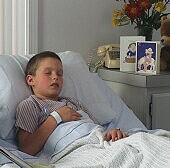
WEDNESDAY, July 25 (HealthDay News) — A new review finds that while children account for almost 60 percent of those with five common medical conditions, only 12 percent of clinical trials of drugs for those conditions examined their effects on pediatric patients.
Yet, the review authors noted, previous research has shown that off-label drugs, where the medicine has only been approved for adult use by the U.S. Food and Drug Administration, make up as much as 79 percent of the medications given to children in hospitals and up to 56 percent of drugs prescribed for kids in doctors’ offices.
“We think this contrast is striking, and speaks to the under-representation of research on kids,” said review author Dr. Florence Bourgeois, an assistant professor of pediatrics at Boston Children’s Hospital and Harvard Medical School in Boston. “Understandably, whenever we see an adverse event the concern is, ‘Could these drugs really be dangerous?’ and we are left wondering.”
The results were released online July 23 in advance of publication in the August print issue of the journal Pediatrics.
The FDA requires that clinical trials demonstrate a drug’s safety and effectiveness for a condition before it approves the drug to treat that condition, but many drugs are only tested in adults. As a result, physicians are often left to rely on trial-and-error to decide how to use drugs off-label in children, the review noted.
Bourgeois and her team found that, while just over 21 percent of people in high-income countries who are afflicted by conditions such as depression, asthma, migraines, schizophrenia and bipolar disorder are children and adolescents, less than 10 percent of clinical trials studying these conditions included patients under the age of 18.
The gap was even wider for developing countries, where children and adolescents bear nearly 62 percent of the disease burden for conditions such as malaria, diarrhea, HIV and depression, but only about 12 percent of clinical trials of treatments for these diseases include pediatric patients.
A number of professional organizations, including the Institute of Medicine, the American Academy of Pediatrics and the Royal College of Paediatrics and Child Health in England, have all published statements on the importance of evaluating medical treatments for children using randomized, controlled trials. A randomized, controlled trial, in which study participants are randomly chosen to either receive a treatment or not, is the gold standard for medical research.
“In some instances, it may be fine to extrapolate adult [dosing] information and scale down, but the way drugs are metabolized and excreted from the body is different in children,” Bourgeois said. “Children might metabolize faster and need a greater dose than one might think just in terms of scaling down.”
Children are also a special patient group because their bodies are still developing, and leaving them out of clinical trials means the possible effects of drugs on their growth go unaddressed, said review co-author Dr. Kenneth Mandl, an associate professor of pediatrics at Boston Children’s Hospital.
In addition, some drugs taken by adults work the opposite way in kids, explained Albert Wertheimer, a professor of pharmacoeconomics at Temple University in Philadelphia.
“Drugs for [attention-deficit disorder] are stimulants that people take to stay up for a test, but when used in kids, they settle them down,” Wertheimer noted.
For the review, Bourgeois and her colleagues reviewed all the clinical trials that were registered at ClinicalTrials.gov, the largest repository of clinical trials conducted around the world, between 2006 and 2011 for major pediatric conditions.
One reason for the lack of pediatric clinical trials could be who pays for them: The current study found that, while half of funding for trials on adults came from industry sources such as drug makers, the major source of funding for trials on kids was nonprofit groups.
Although the lack of industry funding of children’s drug trials could be viewed as a good thing because industry backing has been shown to introduce biases, “it’s tricky because there are limited resources when it comes to nonprofits, so it would limit the amount you can do,” Bourgeois explained.
Pharmaceutical companies make a “conscious decision” to exclude children from trials of their drugs because it is more difficult and expensive to recruit children and get parental consent, and they have a higher rate of dropping out of trials, Wertheimer said.
On top of that, the payoff is higher for adults, Mandl said. “There are even larger markets of adult chronic conditions that are in the sweet spot for profitability of blockbuster drugs.”
In an effort to spur drug research in kids, the U.S. government has been offering financial incentives to drug companies that carry out pediatric studies for more than a decade.
But, Bourgeois thinks that more is needed. “It should be a combination of financial incentives and some requirements around what drugs need to be tested in children,” she explained.
And, in high-income countries, the drugs to treat mental illness should require the most research. “It’s really neuropsychiatric conditions that have overtaken physical impairments,” Bourgeois explained. “Children might be deprived of effective treatments if clinicians are not willing to use drugs off-label in them.”
Wertheimer agreed that greater requirements for pediatric clinical trials might be in order.
“For any drug that has a high probability of being used in children, it wouldn’t be a bad idea to mandate that the drug be tested in some population of children,” said Wertheimer, who added that drugs such as antibiotics would likely have a large market in children.
In the meantime, the pace of research in children is at least picking up, even if the rate has not been increasing as much as it has for adults, Bourgeois noted.
More information
You can learn more about pediatric studies in children by visiting the Institute of Medicine.

